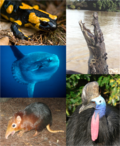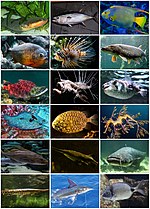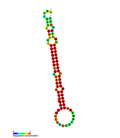Euteleostomi (Eu-teleostomi, where Eu- comes from Greek εὖ 'well, good' or Euteleostomes, also known as "bony vertebrates") is a successful clade that...
10 KB (710 words) - 10:57, 26 October 2024
Osteichthyes can be compared to Euteleostomi. In paleontology the terms are synonymous. In ichthyology the difference is that Euteleostomi presents a cladistic view...
32 KB (2,199 words) - 10:58, 26 October 2024
closely related to true bony fish. Living teleostomes constitute the clade Euteleostomi, which includes all osteichthyans and tetrapods. Even after the acanthodians...
6 KB (458 words) - 10:56, 26 October 2024
Cartilaginous fishes (sharks, rays, ratfish) Euteleostomi ('bony fish')...
49 KB (3,812 words) - 13:08, 31 December 2024
Euteleostomi / Osteichthyes (bony vertebrates)...
104 KB (10,594 words) - 16:53, 9 December 2024
Chondrichthyes (cartilaginous fishes) Osteichthyes/ Euteleostomi...
18 KB (1,744 words) - 08:15, 28 November 2024
lineage is: Catarrhini, Chordata, Craniata, Euarchontoglires, Eukaryota; Euteleostomi, Eutheri and others. "Human PubMed Reference:". National Center for Biotechnology...
2 KB (205 words) - 14:53, 12 June 2022
Acanthodians, incl. Chondrichthyes (cartilaginous fishes) Euteleostomi / Osteichthyes ...
29 KB (2,021 words) - 21:52, 30 November 2024
(Actinopterygii and Sarcopterygii) form a taxonomic group called Osteichthyes (or Euteleostomi, which includes also land vertebrates); they have skeletons made of bone...
91 KB (7,814 words) - 14:15, 18 December 2024
Taxonomic lineage eukaryota → metazoa → chordata → craniata → vertebrata → euteleostomi → mammalia → eutheria → euarchontoglires → primates → haplorrhini → catarrhini...
18 KB (2,080 words) - 09:54, 4 January 2024
miRBase family MIPF0000067 NCBI Gene 407008 HGNC 31603 OMIM 300694 Other data RNA type microRNA Domain(s) Eukaryota; Euteleostomi PDB structures PDBe...
16 KB (1,954 words) - 12:43, 13 September 2024
Phylum : Chordata Subphylum : Vertebrata Superclass : Gnathostomata Euteleostomi : bony vertebrates Actinopterygii : ray-finned fishes Order : Beloniformes...
3 KB (213 words) - 20:23, 2 April 2024
miRBase family MIPF0000053 NCBI Gene 407004 HGNC 31599 OMIM 612077 Other data RNA type microRNA Domain(s) Eukaryota; Euteleostomi PDB structures PDBe...
6 KB (791 words) - 20:27, 27 December 2024
miRBase family MIPF0000108 NCBI Gene 406986 HGNC 31581 OMIM 611899 Other data RNA type microRNA Domain(s) Eukaryota; Euteleostomi PDB structures PDBe...
23 KB (3,026 words) - 01:19, 26 June 2024
following lineage: Eukaryota; Metazoa; Chordata; Craniata; Vertebrata; Euteleostomi; Mammalia; Eutheria; Euarchontoglires; Primates; Haplorrhini; Catarrhini;...
2 KB (198 words) - 20:32, 23 June 2024
miRBase family MIPF0000058 NCBI Gene 406988 HGNC 31583 OMIM 613147 Other data RNA type microRNA Domain(s) Eukaryota; Euteleostomi; PDB structures PDBe...
21 KB (2,700 words) - 09:51, 3 June 2024
lineage of TMEM156 is: Eukaryota; Metazoa; Chordata; Craniata; Vertebrata; Euteleostomi; Mammalia; Eutheria; Euarchontoglires; Primates; Haplorrhini; Catarrhini;...
12 KB (901 words) - 20:28, 5 December 2024
suggests that it localizes to the cell membrane. LRRC24 is conserved in Euteleostomi with the exception of Aves. Also, based on sequence homology analysis...
10 KB (941 words) - 02:28, 3 December 2023
mediate protein–protein interactions. MAP3K1 is highly conserved in Euteleostomi. The spontaneous recessive lidgap-Gates mutation (deletion of Map3k1...
33 KB (3,171 words) - 06:42, 28 November 2024
















